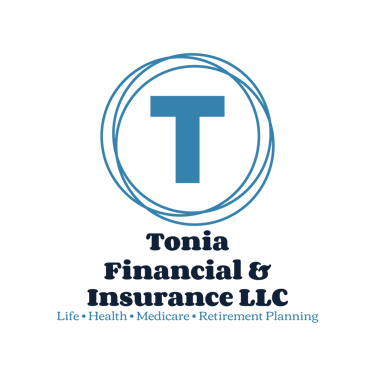Step 2 of Financial Independence: Building an Emergency Fund
Financial independence isn’t just about growing wealth—it’s also about protecting what you have. After tackling step one—reducing high-interest debt and lowering credit utilization to under 50%—the next priority is building a strong emergency fund. This financial cushion is essential for avoiding debt traps, maintaining stability during setbacks, and staying on track toward your long-term goals.
Tonia Perry
3/7/20253 min read


Financial independence isn’t just about growing wealth—it’s also about protecting what you have. After tackling step one—reducing high-interest debt and lowering credit utilization to under 50%—the next priority is building a strong emergency fund. This financial cushion is essential for avoiding debt traps, maintaining stability during setbacks, and staying on track toward your long-term goals.
Why an Emergency Fund Matters
Unexpected expenses will happen. Whether it’s a sudden job loss, car repair, medical bill, or home maintenance issue, an emergency fund prevents these surprises from derailing your financial progress. Without savings, many people rely on credit cards or loans, which can quickly spiral into debt.
Having an emergency fund allows you to:
✔ Cover essential expenses without borrowing.
✔ Reduce stress and financial anxiety.
✔ Stay focused on wealth-building instead of crisis management.
How Much Should You Save?
Your emergency fund should be tailored to your needs, but a general rule of thumb is:
Starter Fund: $500–$1,000 (for those in early debt payoff stages)
Basic Emergency Fund: 3 months of essential expenses
Fully Funded Emergency Fund: 6–12 months of expenses (for those who are self-employed or in unstable industries)
What counts as essential expenses?
Rent/Mortgage
Utilities
Groceries
Transportation
Insurance premiums
Loan minimum payments
Where to Keep Your Emergency Fund
An emergency fund needs to be safe, accessible, and separate from your daily spending. The best options include:
✅ High-Yield Savings Account – Keeps your money growing with interest while staying liquid.
✅ Money Market Account – Offers slightly higher interest rates and check-writing privileges.
✅ Separate Checking Account – Easy to access in emergencies but not mixed with everyday spending.
Avoid stocks, crypto, or investment accounts for emergency savings—market volatility can cause losses right when you need the money most.
How to Build Your Emergency Fund (Even on a Tight Budget)
1. Pay Yourself First
The best way to build an emergency fund is to treat savings like a bill. Instead of waiting to see what’s left over after paying expenses, commit to saving a set amount first.
How to implement the Pay Yourself First strategy:
Set up an automatic transfer from your paycheck to your emergency fund every payday.
Start with 10% of your income, or as little as $25 per paycheck—small amounts add up!
Treat it like a non-negotiable expense, just like rent or a car payment.
This method ensures that savings is a priority, not an afterthought.
2. Start Small, Stay Consistent
If saving feels overwhelming, start with whatever you can. Even $5 or $10 per paycheck makes a difference over time. The key is consistency.
3. Use Windfalls Wisely
Tax refunds, bonuses, birthday money, or side gig income? Deposit a portion into your emergency fund before spending it.
4. Cut Expenses Temporarily
Look for small sacrifices you can make:
Reduce takeout and coffee runs.
Cancel unused subscriptions.
Switch to a cheaper phone or internet plan.
Every $5 saved is $5 closer to your goal.
5. Automate Your Savings
If you struggle with saving, set up an automatic transfer to your emergency fund each payday. This removes the temptation to spend it.
6. Use Cash Back & Rewards
If you have a rewards credit card (and pay it off in full), consider redeeming cash back for savings. Some apps like Rakuten or Fetch Rewards also offer small cash rewards that can go straight into savings.
7. Boost Your Income
If possible, find small ways to earn extra money, like:
✔ Taking on a side hustle (freelancing, DoorDash, selling items online)
✔ Doing overtime (if available at your job)
✔ Monetizing a skill (tutoring, baking, handyman work)
When to Use Your Emergency Fund
This fund is for real emergencies, not impulse purchases or vacations. Before withdrawing, ask yourself:
❓ Is this unexpected?
❓ Is this necessary?
❓ Is there no other way to cover this expense?
Good reasons to use your fund:
✅ Job loss or income drop
✅ Urgent medical or dental bills
✅ Car or home repairs that affect daily life
✅ Unexpected travel (e.g., funeral, family emergency)
Bad reasons to use your fund:
🚫 Holiday gifts
🚫 Concert tickets
🚫 Non-essential home upgrades
If you do use your emergency fund, make a plan to replenish it ASAP by adjusting your budget and refocusing savings efforts.
The Power of an Emergency Fund on the Road to Financial Freedom
A strong emergency fund is step 2 toward financial independence because it acts as a financial safety net. With this foundation, you can:
✔ Avoid high-interest debt when emergencies arise.
✔ Focus on growing wealth (investing, homeownership, business).
✔ Gain peace of mind knowing you’re financially secure.
Once you’ve saved at least 3 months’ expenses, you can confidently move on to step 3: investing and building long-term wealth.
What’s your emergency fund goal? Let me know in the comments!
4o
You said:

EMAIL: Strive.tonia@gmail.com
PHONE:(216)800-7303
© 2025. All rights reserved.
We do not offer every plan available in your area. Currently, we represent 9 organizations which offer 80 products in your area. Please contact Medicare.gov, 1-800-MEDICARE, or your local State Health Insurance Assistance Program (SHIP) to get information on all of your options. This is a proprietary website and is not associated, endorsed or authorized by the Social Security Administration, the Department of Health and Human Services or the Center for Medicare and Medicaid Services. This site contains decision-support content and information about Medicare, services related to Medicare and services for people with Medicare. If you would like to find more information about the Medicare program please visit the Official U.S. Government Site for People with Medicare located at http://www.medicare.gov
Independent Insurance Agent | Final Expense Insurance Ohio | Medicare Advantage Plans Cleveland | Life Insurance for Children | Medigap Plans PA | Insurance Advisor for Seniors | Community Insurance Help
